Any busy dog owner knows the drill: You wake up early to the pitter patter of Fido’s toenails on the wood floor. Your dog wants to follow you around all day, but you need to get things around the house done!
Why not keep your dog calm and occupied with something tasty to chew? Like, perhaps, a big ‘ol piece of rawhide.
Chewing is an innate instinct for our furry friends — whether your baby is a puppy or full grown, having something to chew on can calm his nerves, keep him from getting bored, and may help keep those teeth clean.
But is rawhide the best thing to give your bored canine to chew? Read on to find out.
Best Rawhides for Pets: Key Takeaways
- Rawhides are untanned (“raw”) cow hides that can keep dogs busy chompin’ away for long periods of time.
- Rawhides vary wildly in terms of quality, so you’ll want to be selective when picking out a specific product for your pooch.
- Rawhides can present some safety issues, so owners should use care when offering them to a pet and be sure to supervise closely.
Things to Look for When Picking a Rawhide Chew

As mentioned, rawhides vary a great deal in terms of quality and safety. A lot of this variation relates to:
- The initial source of the hides
- The country in which the hides are processed
- The distance between tannery and processing plant
- The methods a manufacturer uses to process the hides
- The way the hides are cut and pressed for sale
- The flavorings and additives applied to the hides
- The thickness and shape of the hides
To the extent possible, you’ll want to consider all of these things when picking out a rawhide for your pooch. However, some of this information can be tricky to track down.
But, by following the tips below, you’ll be able to avoid most of the low-quality rawhides on the market and set your dog up with a safe (and delicious) chew.
- Pick a rawhide that’s made in the USA. US-made rawhides are typically the safest, highest-quality options available. They may cost a bit more than rawhides made in Asia, but you don’t want to let a couple of bucks stand in the way of your pet’s health and well-being. Rawhides made in Canada, Australia, New Zealand, or Western Europe are also likely to be safer than Asian versions.
- Use caution with multi-piece rawhides. Some rawhides are made from multiple pieces. They may, for example, feature differently flavored “strips” that are twisted together. These are often beloved by pooches, who often have fun pulling them apart, but they’re also more likely to break off in large pieces, which may lead to choking. Just be sure to use additional caution with these types of rawhides and supervise your dog closely. Alternatively, you can just stick to single-piece rawhides.
- Avoid super-white rawhides. Super-white rawhides have usually undergone some form of dying or bleaching, which may have involved potentially dangerous chemicals, such as titanium dioxide. Look for rawhides that are somewhere between off-white, cream, or light yellow, as these have usually been subjected to gentler processing methods.
- Buy rawhides that have been washed thoroughly. Most high-quality rawhides are subjected to one or more washing cycles to help ensure they’re clean. Washing also helps to reduce or eliminate any of the remaining chemical residues left over from processing. Note that the washing process costs money, so expect to pay a bit more for rawhides that have been washed one or more times.
- Pick rawhides that are as gently processed as possible. All rawhides need to undergo some kind of disinfection and processing, but you’ll want to try to avoid those treated with potentially dangerous disinfectants like formaldehyde.
- Consider compressed rawhides. Compressed rawhides are processed a little differently than traditional, sheet- or roll-style rawhide treats. This leads some vets — such as Dr. Courtney Campbell in the video below — to believe that compressed rawhides are safer and less likely to cause mouth injuries or obstructions.
Best Rawhide Dog Chews
Now that you understand some of the most important things to look for when picking a rawhide, we can share some of our favorites! Check out the best rawhides for dogs below!
1. Raw Paws Compressed Rawhide Sticks
About: Up your chompin’ buddy’s fun with Raw Paws Compressed Rawhide Sticks, natural chews made with zero artificial colors, flavors, or preservatives. Containing only 100 percent beef hide compressed into a tough-as-a-terrier stick, each chew measures 10 inches long and is the perfect shape for your canine to cradle between paws as he gnaws. These chews are also designed to dissolve instead of break down into little pieces, making for easier cleanup and safer chewing.
Features:
- Each resealable package contains 5 chews
- Doesn’t expand when wet or swallowed
- Dried without the use of potentially dangerous chemicals
- Materials sourced from India and South America before being inspected and packed in the USA
Pros
- Made from only beef hide with no added colors, flavors, or preservatives
- Several owners praise the longevity of these chews, even against heavy chewers
- Single-ingredient recipe ideal for dogs with sensitivities
- Resealable bags helps unused chews stay fresh
Cons
- Picky pups aren’t always fans of the taste
- Too large for small doggos
2. Pet Factory 8″ Rawhide Roll
About: Pet Factory Rawhides are made in USDA-certified, Illinois-based facilities using only beef hide from US-raised cattle. If you’re searching for some straightforward and safe rawhides, these may be exactly what you want, as they lack artificial preservatives, chemicals, and grains. They’re also available in several package counts, ranging from 2 to 50!
Features:
- Rawhides measure approximately 8 inches long
- Available in flavors including Natural, Beef, Peanut Butter, and Chicken
- Manufactured in accordance with GFSI quality standards
- Rolled design lasts longer than rawhide sheets or chips
Pros
- Most pupper parents report these chews last a pretty long time
- Made in America with US-sourced cattle
- Wide variety of package counts (including high number) ideal for multi-pup packs or stocking up
Cons
- Some pawrents aren’t fans of the smell of these chews (a common complaint with natural dog chews)
- May be too large for little dogs to chew
3. Lucky Premium Treats Small Chicken Wrapped Rawhide
About: Looking for rawhide treats that pack a little more flavor for Fido? Look no further than Lucky Chicken Wrapped Rawhide. Featuring a standard rawhide core, these treats come with chicken breast slices wrapped around the outside, enticing your pup to keep gnawing and making each chew enriching as he peels and pulls away more deliciousness.
Features:
- Made with two ingredients: plain rawhide and 98% fat-free chicken breast
- Made in the USA with no harmful additives or preservatives
- These treats come packaged in a resealable bag to maximize freshness
- Treats measure about 5 inches long (suitable for small and toy breeds)
Pros
- Most dogs go bonkers for the taste of these chicken-wrapped chews
- Perfect sizing for petite pups
- Resealable package helps keep your doggo’s unused chews fresher for longer
Cons
- Some dogs simply remove the chicken and ignore the inner chew
- Not all canines can tolerate chicken
4. Pet Factory 7″ Braided Sticks
About: Pet Factory Peanut Butter Rawhides are all-natural rawhides that come in braided form, which means they’ll often last a little longer for your pooch and provide a bit more mental stimulation than single-piece rawhides will. If your pooch isn’t a fan of peanut butter, there are also Natural, Chicken, and Chicken & Beef flavors available.
Features:
- Made without artificial additives or preservatives
- Peanut-butter flavored for maximum pup appeal
- Made in the USA with US-sourced cattle in accordance with GFSI quality standards
- Treats measure 7 to 8 inches
Pros
- Most dogs seem to love the peanut-buttery taste
- Owners report these rawhides lasting longer than other options
- Braided design more enriching than standard stick-style chews
Cons
- A few owners reported these rawhides stained carpets, so offer these to your pup on hard, easy-to-clean surfaces
- May be too thick for small breeds to chew
5. Canine Chews Premium American Beef Hide
About: Canine Chews Premium American Beef Hide gives you the best bang for your buck with large-count packages of rolled real hide, designed to last longer as your pooch chews. These chews are free of preservatives and only contain a single ingredient: beef hide. Measuring 10 to 11 inches in length, these will work best with medium to large-sized doggos.
Features:
- Packed in 20- and 50-count resealable packages
- Odor and dye-free so chews won’t stain carpets
- Each roll measures 3/4″ thick
- Made in Mexico with US-sourced cattle
Pros
- Price tag won’t wallop your wallet, even for a large package count
- Length ideal for big doggos
- Won’t stain furniture or rugs
Cons
- May be too large for petite pooches
- Not every pooch parents likes to buy in bulk
- Some dog owners prefer made-in-the-USA chews
What Is Rawhide Made Of, Really?
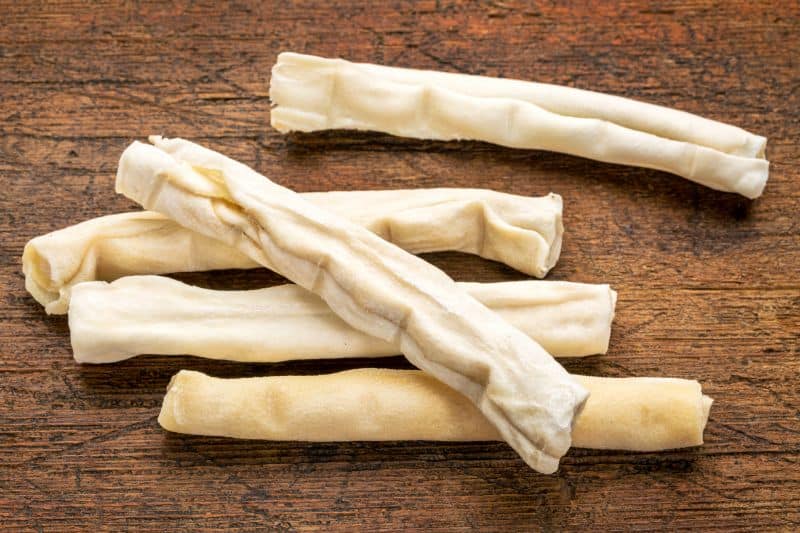
Rawhide is exactly what it sounds like it is — a hide that is “raw”, meaning that it hasn’t been exposed to any tanning processes. They are usually made from the inner layer of a cow’s hide, and they are marketed specifically as chews for dogs.
Rawhide processing is pretty straight-forward, even if there are several different variations of the process. Generally speaking, the hides are first removed, cleaned, split, and cut. Then, the dried animal skin is rolled and pressed into shapes, many times with added flavors.
The Rawhide Controversy: Are Rawhides Safe For Dogs?

There is a fair amount of controversy surrounding rawhides for dogs — even among veterinarians. Some think they’re relatively safe, beneficial treats for dogs, while others think the risks they present are simply too grave to ignore.
We’ll review some of the dangers associated with rawhides below, so that you can make an informed decision before offering them to your floof.
Danger #1: Rawhides May Cause Dogs to Choke
Perhaps the most serious danger rawhides present is that they occasionally cause dogs to choke.
Choking typically occurs when a dog tries to swallow a piece that is simply too large to pass down his esophagus. It can also happen when a rawhide piece becomes stuck to the roof of his mouth or the back of his throat.

In a best-case scenario, your dog will somehow manage to get it down. This will cause him some pain and discomfort, and you’ll both likely experience a great deal of stress.
But that’s better than a worst-case scenario, in which a piece of the rawhide blocks the opening to his windpipe.
Choking is an immediate medical emergency, during which your dog will be unable to breathe. You’ll have to head directly to the vet’s office or emergency clinic and hope they can help.
Choking is more likely to occur in dogs who are “gulpers” — those who inhale their dinner in a matter of seconds or try to choke down anything they get their mouth on. These types of problems are less likely to occur with “nibblers” and dogs who eat in a more relaxed, deliberate fashion.
But there are no guarantees, so owners should always be aware that rawhides may cause choking.
Danger #2: Rawhides Can Lead to Broken Teeth
Some rawhides are harder and tougher than others.

Some are pretty pliable and will flex when twisted or bent, but others are nearly rock-hard and tough as nails.
In some cases, the harder varieties can result in broken teeth, bleeding mouths, and other oral dangers (these stiffer rawhide are also more difficult for your dog to digest, but that’s a whole other issue that we’ll cover in a minute).
So, to avoid expensive trips to the doggie dentist, try to pick the softer versions, with a bit of give to them.
The dental dangers associated with rawhides are a bit ironic, considering one of the major benefits rawhides provide is their ability to help clean your dog’s teeth.
However, choosing a softer rawhide can reduce these risks, while still allowing your dog to enjoy the tooth-scraping benefits rawhides can provide.
Danger #3: Some Rawhides Are Subjected to Dangerous Treatments
While most rawhide chews are made by manufacturers who follow a similar process of de-hairing, treating, and cutting hides, they implement a variety of other treatments, which vary from one company to the next.
Unfortunately, some of these treatments may not be safe for your dog.
For example, some Asian tanneries may use arsenic to de-hair the hides, while others may be treated with formaldehyde or use excessive amounts of lime to preserve the hides prior to processing.
Heavy washing and rinsing can eliminate the vast majority of these contaminates, but because the washing process is time consuming and expensive, some factories will simply skip the extra washing.

There are other problems that result from a shorter washing time. A shorter wash time also results in rawhides that are harder and stiffer. These harder pieces of rawhide are more difficult for your dog to digest are more likely to result in damaged teeth.
Avoid rawhides that have the bleached white look, as they have likely been treated with titanium dioxide.
Titanium dioxide is a preservative used in some human foods, but there is some evidence that suggests it may represent a health hazard. Accordingly, the FDA requires manufacturers producing human food to use specially prepared food-grade quality titanium dioxide.
However, because rawhides don’t need FDA-approval, unethical manufacturers may use low-grade titanium dioxide, which may present a health risk to your dog.
Titanium dioxide may also cause your dog’s rawhide to become “pasty” once wet — something most doggos don’t find appetizing.
PRO TIP: A natural, well-manufactured rawhide will have a bit of give when twisted, and it will have a slight golden hue rather than the pure bleached white color some exhibit.
Danger #4: Digestive Issues and Dangers
While some dogs seem to digest rawhides without issue, others can suffer from a variety of digestive issues after eating one. In fact, digestive issues are probably the most common problem owners report with rawhides.
Things like vomiting, diarrhea, and stomach pain can plague dogs who consume and swallow rawhides, but these types of issues usually resolve on their own with time.
However, more serious problems — such as intestinal blockages — can also occur. Blockages are a medical emergency, which will often require surgery to correct.
You can’t completely eliminate these possibilities, but by opting for softer, more responsibly-processed rawhides, you can reduce the threat of tummy troubles.
The Benefits of Rawhides: Why Give Them to Your Pooch?
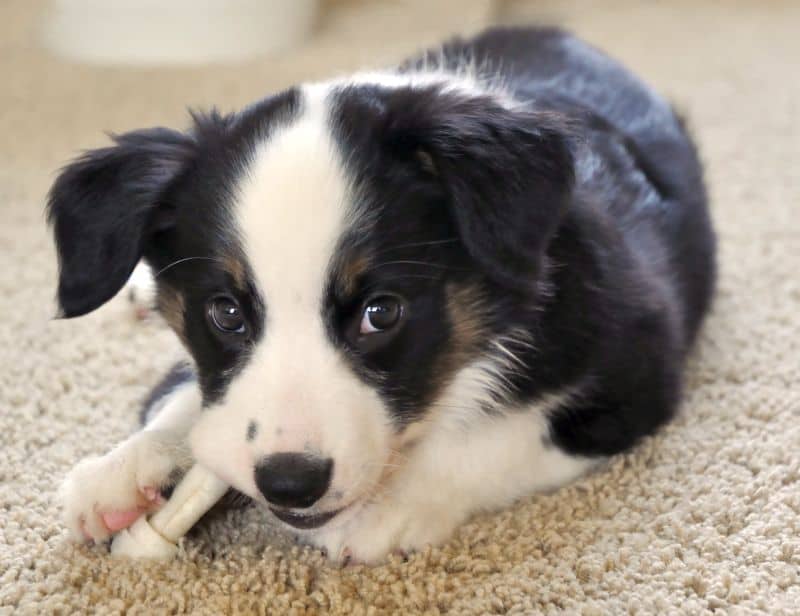
Rawhides do present a few safety hazards, which may lead some owners to wonder about the benefits they provide. Is it even worth the risk to offer them to your pet?
We’d answer with a qualified “yes.”
You certainly need to select rawhides that are likely to be safe (more on this in a moment) and offer them in a safe manner, but they do provide several benefits to your pet.
- Rawhides make most pooches happy. Sometimes, there’s no need to over complicate things. You love your pet, so you want his little pup brain pumping out endorphins as often as possible. Rawhides work beautifully in this manner, as most doggos will “lose themselves” in a whirlwind of chewing joy when given one.
- Rawhides serve as a helpful distraction. While dogs vary in their drive to chew, some are certainly compelled to work out their chompers as often as possible. And if you don’t give these dogs something to chew, they’ll find something on their own. So, if your dog has a propensity to eat your socks or go digging through the bathroom trashcan, you may want to give him rawhides or other things he can chew.
- Chewing on rawhides may promote dental health. In addition to tasting great, rawhides may offer dental benefits too. All that chomping may help reduce plaque build-up and slow down tooth decay. Just remember that a consistent teeth brushing routine and trips to the doggie dentist to get your pooch’s teeth professionally cleaned are still essential. But giving your pup dental doggie treats and chews can help support a strong set of chompers.
Perfect Situations for Rawhide Dog Chews

Just as many humans consider any time to be a good time for chocolate, Fido probably thinks about rawhides the same way.
But as a good pet parent, you should be careful to offer rawhides in moderation. Too much of anything — even a good thing — can be a problem.
Here are a few of the times in which it makes the most sense to give your pooch a rawhide chew:
- Your sweet pooch is teething. As your puppy ages, he will be very grateful for any help with the teeth-shedding process that you can offer. When young puppies teeth, they are attempting (in part) to soothe sore gums while their grown-up teeth come in. Chewing while teething offers your puppy a way to cope with the pain of new teeth growing up through his gums.
- Your dog is anxious or nervous. Repetitive chewing of hard or crunchy objects can be therapeutic for some dogs with generalized anxiety, separation anxiety, or other issues that cause them to feel nervous.
- Your doggo deserves a reward. It is always a good idea to reinforce good habits and behaviors, and a rawhide can work marvelously in this context. So, if your dog behaved well during a walk or got through the entire day without chewing up your shoes, you may want to consider giving him something fun and tasty to gnaw on.
Rawhide Safety Tips

While you can’t eliminate all of the danger associated with rawhides, you can drastically reduce the chance of problems by implementing the following safety tips:
- Always supervise your dog when he’s enjoying a rawhide. Watch him carefully, and avoid running into the other room or allowing yourself to become distracted. Be ready to take away any pieces that are small enough to fit in your dog’s mouth.
- Select rawhides of the proper size. You want to give your dog rawhides that are small enough for him to handle, but large enough that they aren’t easy for him to swallow. Just try to picture your dog’s mouth, and then pick rawhides that are a bit bigger.
- Inspect the rawhide before giving it to your pooch. Always check rawhides carefully before giving them to your dog. If you see anything unusual — including cracks, discoloration, or sharp edges — avoid giving it to your dog.
- Discard chewed rawhides after a few days. Rawhides often last gentle chewers for several days, but you don’t want to allow your dog to chew on one for weeks at a time. Because the rawhides get wet, they can become fouled with bacteria, which may make your pupper sick.
What Do You Do If Your Dog Starts Choking on a Rawhide?

If your dog begins to choke on a rawhide, you’ll need to attempt to remove the rawhide piece manually. Use care to avoid being bitten, and try to be gentle for your pup’s sake — he’ll likely be pretty scared during the process.
If you can’t remove the piece quickly, you’ll need to rush your pooch to the emergency vet. Hopefully, your vet will be able to remove the piece, so your dog will get through the ordeal relatively unscathed.
This is a good time to point out the importance of knowing canine CPR as well as the Heimlich maneuver for dogs in case they start choking.
Some Frequently Asked Questions about Rawhides

The entire subject of rawhides and dogs generates a lot of owner questions to chew through. We’ll try to answer some of the most common queries below to help you out!
Are rawhides safe for puppies?
Many puppies love rawhides, and they are good for the dental health of little doggos — especially during the uncomfortable teething period.
As long as you select a high-quality rawhide and purchase the right size (a bit larger than your puppy’s mouth), rawhides are generally as safe for puppies as they are adult dogs.
Just be sure to monitor your pup while enjoying the treat, and take it away from him once it becomes small enough to fit inside his mouth.
How are rawhides made and processed?
The rawhide creation process begins at the tannery, where hides are de-haired and then treated with a chemical to puff up the hide, which makes it easier to split the hide into two layers.
The top layer is used for leather goods like purses and shoes. The bottom layer is the one that is commonly used for rawhide dog treats.
Next, those bottom layers of hide are taken to be processed at a plant. In some cases, the hides are frozen or treated with a lime solution if there is a large distance between the plants.
At the processing center, the hides are washed, treated with an antibacterial or bleaching agent, and then finally cut and formed into rawhide shapes and treats.
What can I give my dog instead of a rawhide?
Due to choking and digestibility concerns, some owners may prefer alternatives to rawhides for dogs. Fortunately, there are a few options available.
Bully sticks and beef collagen chews are some of the best chews and make great alternatives to rawhides, but there are many others too. Just check out our full guide to the best dog chews for more info!
Is rawhide digestible for dogs?
Rawhide digestibility appears to vary from dog to dog.
Some doggo stomachs appear to break the hides down a good bit, but others tend to pass rawhides without digesting them much at all. Additionally, some rawhides are more digestible than others.
However, generally speaking, rawhide isn’t particularly easy for dogs to digest, and they may not breakdown the pieces completely. A 2012 study found that rawhide digestibility levels varied between 50% and 85% for the dogs in the trial.
That’s part of the reason rawhides can cause intestinal obstructions. And even if they don’t clog up your canine, they’ll likely pass through his system relatively unchanged, so you may see identifiable pieces in your pupper’s poop.
Rawhide chews are certainly a bit of a controversial subject among dog owners, but many find that the benefits outweigh the potential dangers they present and offer them to their dog regularly.
Just be sure to follow the safety tips provided above and do your best to select the highest-quality rawhide chews you can.
How do you feel about rawhides? Do you think they’re a valuable treat or simply too dangerous to give to your pooch? Have you found a specific rawhide product or brand you like more than others?
Let us know in the comments below!
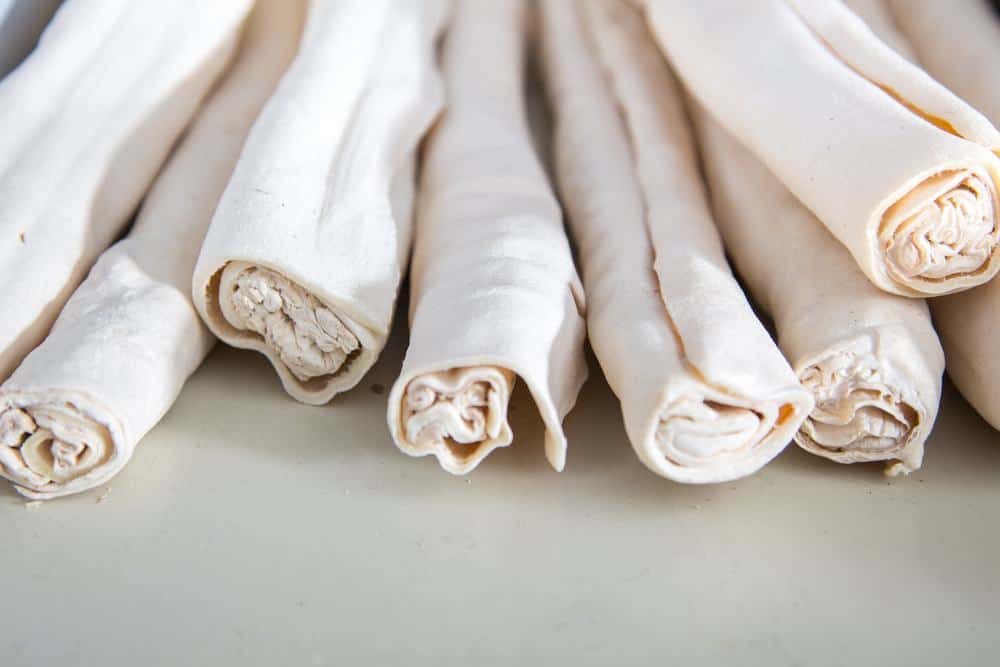

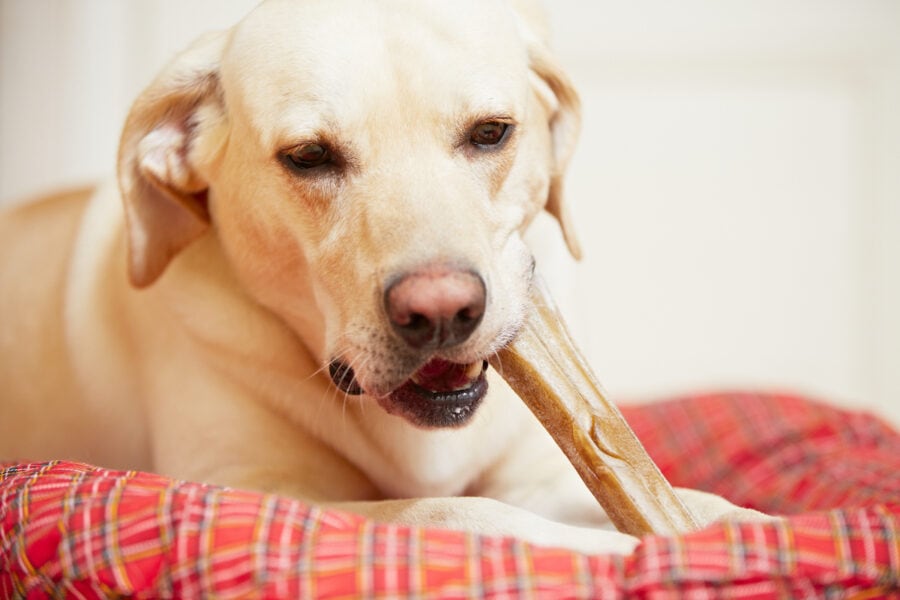


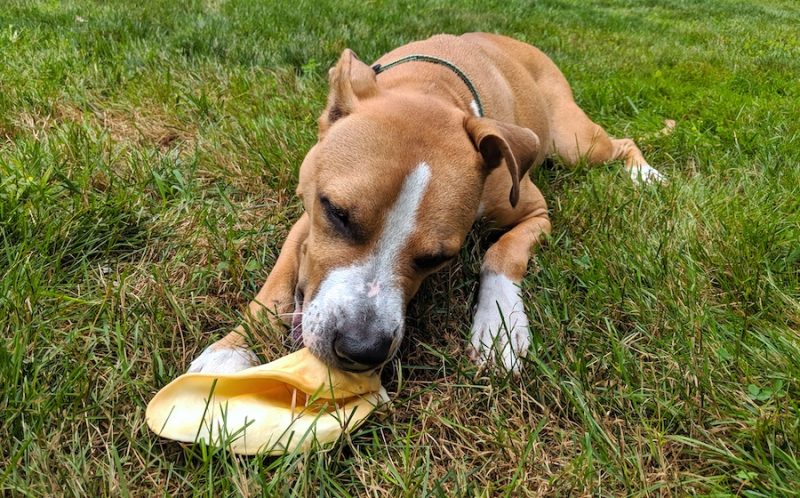

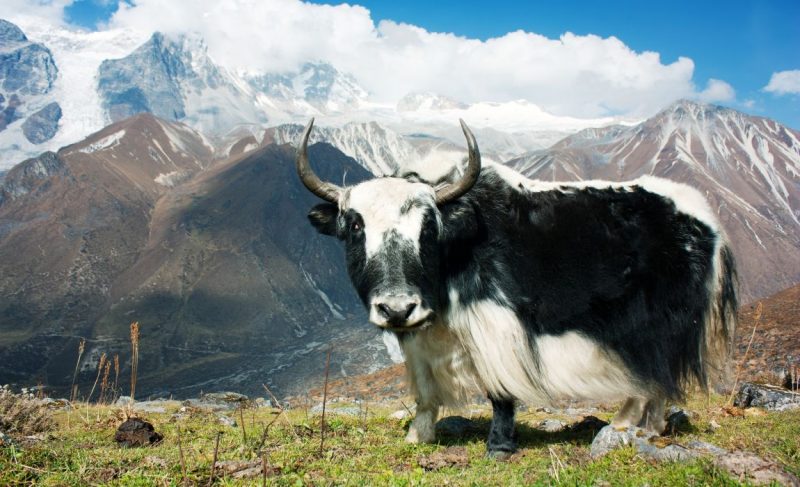
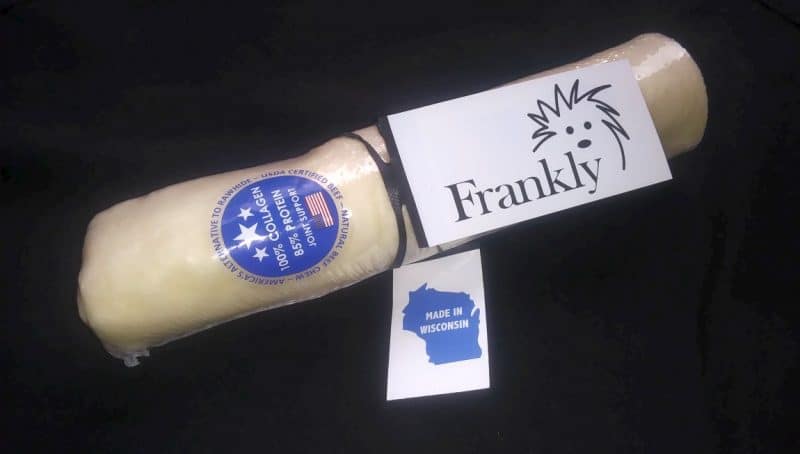
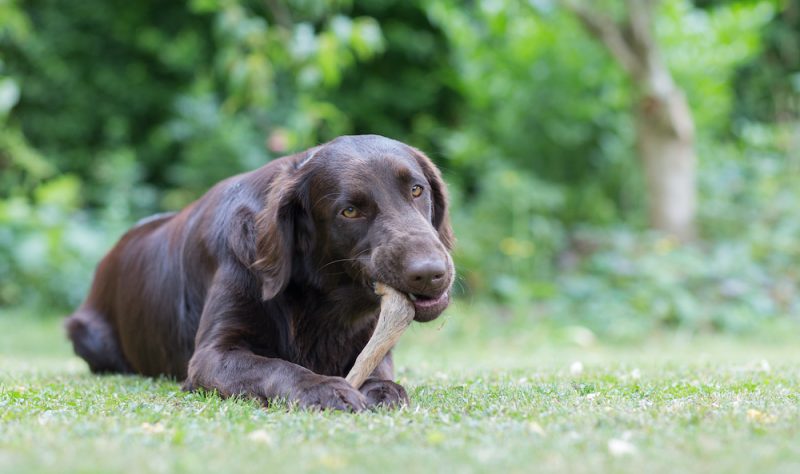

Leave a Comment